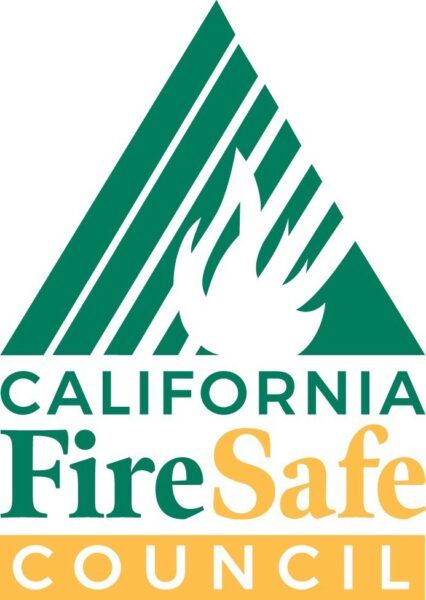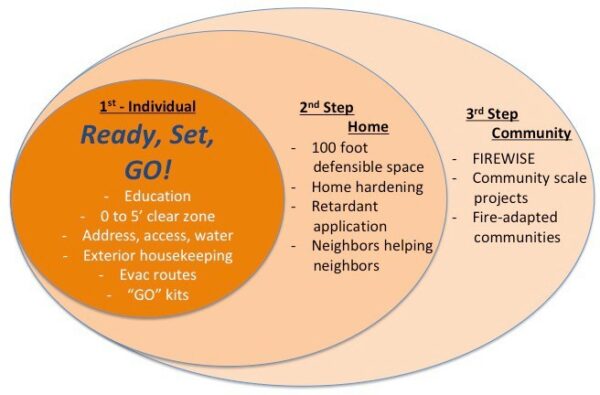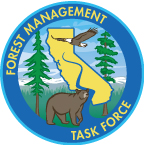
CFSC COVID-19 Strategy: Advice to Our Partners
Our world has changed! The COVID-19 does not have an expiration date as of this moment and we must recognize that the 2020 fire season will come and go, regardless of the virus. California residents are all too familiar with our wildfire problem and our State’s wildfire response system may become stressed due to COVID-19 issues. We must take action to prepare today!
Recognizing these basic facts, the CA Fire Safe Council is offering this advice to residents and local Fire Safe Councils. Because of the unknown duration and impacts of the COVID-19 virus, consider this strategy from the individual level to the community level while using appropriate “social distancing” practices:
 |
1st Step – Individual Action
Individual actions are those that a single person can accomplish wearing a mask and not violating “social distancing” practices of six feet separation between individuals. Start with the basic individual preparation steps in the Ready, Set, GO! program and the best practices for COVID-19 safety below. “Ready” is a two-part action: education and taking personal action steps. Become aware of the educational materials provided by your local fire department, Fire Safe Council, FAC, FIREWISE and insurance companies. The goal here is to increase your understanding / situational awareness of your wildland fire problem and fire behavior in your geographical area. You should then learn how to take basic steps to prepare your home and understand evacuation routes/terms and procedures.
While practicing “social distancing,” go outside of your home and remove combustible vegetation, greenwaste/mulch, or bark within the first 5-feet surrounding your home. Then relocate firewood storage away from the house and remove combustible furniture and other flammable materials. Clean out your gutters and remove the leaf litter on your roof. Ensure that a fire engine can see your address and that they have a 14’ x 14’ clearance from trees and shrubs. Finally, make sure that you have your pool, water tank, hydrant and garden hoses ready, if needed.
“Set” is being ready to evacuate (have your “GO” kit ready) monitoring the weather and “Red Flag” conditions, always being on alert. “GO!” means to act early to self-evacuate or obey law enforcement’s evacuation direction.
The goal is to eliminate the immediate flying ember hazards and to escape safely.
2nd Step – Homes
Depending upon your situation and capabilities, perform or hire someone to create a 100-foot defensible space zone. Ask your contractor to adhere to the recommended COVID-19 safety rules. Begin to take positive actions to harden your home by simply changing attic/sub-floor vent screening size to 1/8” (eave and cornice vents should be baffled).
More elaborate hardening actions can be taken based upon your specific situation. In lieu of doing extensive landscape projects and modifying wood decks, consider applying a fire retardant spray. Most of these products will last for a fire season even with minimal rainfall.
As we finish focusing on our individual home, extend offers to help neighbors, especially those who cannot help themselves. You can begin to build community resilience by expending your mitigation efforts to others, similar to building a chain or barrier.
3rd Step – Community
The third step involves more community scale projects. Typical examples are shaded fuel breaks, improving access roads and conducting fuel treatments. The overall goal is to truly build a fire-adapted community that can withstand a wildfire even if there are no fire resources available.
Closing
These three steps are not absolute nor are they in a mandated priority order. Each person and situation will dictate their ability to prepare their home. Try to do as much preventive work as possible beginning at your home and work outward within COVID-19 safety provisions for you, neighbors and contractors.
Some may question hiring a contractor to do work or having neighbors help. Everyone must try to practice “social distancing” while performing mitigation work. State directives do allow “mitigation” work as an exempted activity for homeowners and contractors. We know that utility companies are focusing on their fire prevention and it should go without saying, that we should do everything possible to prevent any human caused wildfire ignitions.
It is unknown how stressed our firefighting response system may be when wildfires occur, therefore we should all take personal responsibility now. Do not wait to receive a letter or notice from your local fire agency that you need to take action. Time is of the essence in preparing for the heightened fire season and the pandemic situation only exacerbates the urgency and challenges our individual and collective ability for success.
References:
Essential Work – Mitigation https://covid19.ca.gov/img/EssentialCriticalInfrastructureWorkers.pdf
Ready, Set, GO!
https://www.readyforwildfire.org/Prepare-For-Wildfire/
Fire-adapted Community (FAC) Learning Network – Prepardness
https://fireadaptednetwork.org/
CA Fire Safe Council – Home Hardening https://cafiresafecouncil.org/resources/fire-safety-information-for-residents/
FIREWISE
https://www.nfpa.org/Public-Education/Fire-causes-and-risks/Wildfire/Firewise-USA
Questions?
General questions can be emailed to: COVID19CFSC@gmail.com
Please refer all technical and specific questions to your local Fire Safe Council or your local fire agency. The CFSC will try to respond to “general” questions within 48 hours and will post the question (without submitter information) and responses on our website for public sharing.

Coronavirus Guidelines and Best Practices for Fuels Reduction Activities March 31, 2020
Executive Order N-33-20 (“Executive Order”) requires all individuals residing in California to stay at their place of residence except as needed to maintain continuity of operations in various critical infrastructure sectors. The State Public Health Officer developed a list of “Essential Critical Infrastructure Workers” to help state, local, tribal, and industry partners as they work to protect communities, while ensuring continuity of functions critical to public health and safety, as well as economic and national security. That list is available online: https://covid19.ca.gov/img/EssentialCriticalInfrastructureWorkers.pdf.
The list includes, among others:
- Fire Mitigation Activities
- Support, such as road and line clearing, to ensure the availability of needed facilities, transportation, energy and communications
- Workers who support the manufacture and distribution of forest products, including, but not limited to timber, paper, and other wood products
- Vegetation management crews
BEST PRACTICES FOR CREWS:
- If you feel sick, do not go to work. Reach out to your crew leader for
- Use individual vehicles whenever possible for travelling to worksites, unless a minimum of 6 feet of Physical Distancing can be maintained in a van or
- If you normally meet at a central office location, do not go through the office on your way to the job
- Wear gloves and a mask when in groups or in public
- Respect each other’s personal space at all
- Have hand washing stations or antibacterial products available at, or near, the work
- Wash your hands when exposed to possible infection sources such as vehicles and shared equipment such as
- Wipe down tools before, and after work with sanitizing
- Do not share tools if
- Pack and bring your own meal unless one is provided for you from a reputable
- Do not share items such as chewing tobacco, vaping pens, cigarettes or food.
- If you share barracks, use all the above
In all situations use your common sense and utilize recommended Physical Distancing. Be courteous to your fellow workers and recognize this is a stressful time for all of us. Working together we can help reduce the transmission of Covid-19 as well as other more common viruses such as the common cold and flu.
